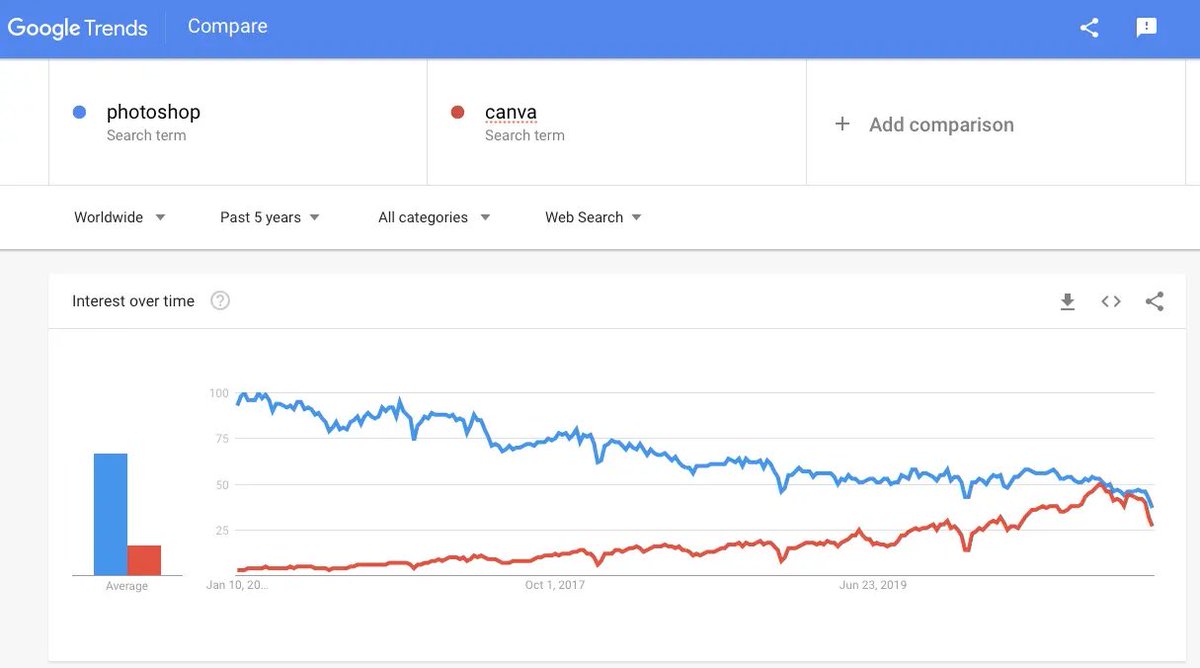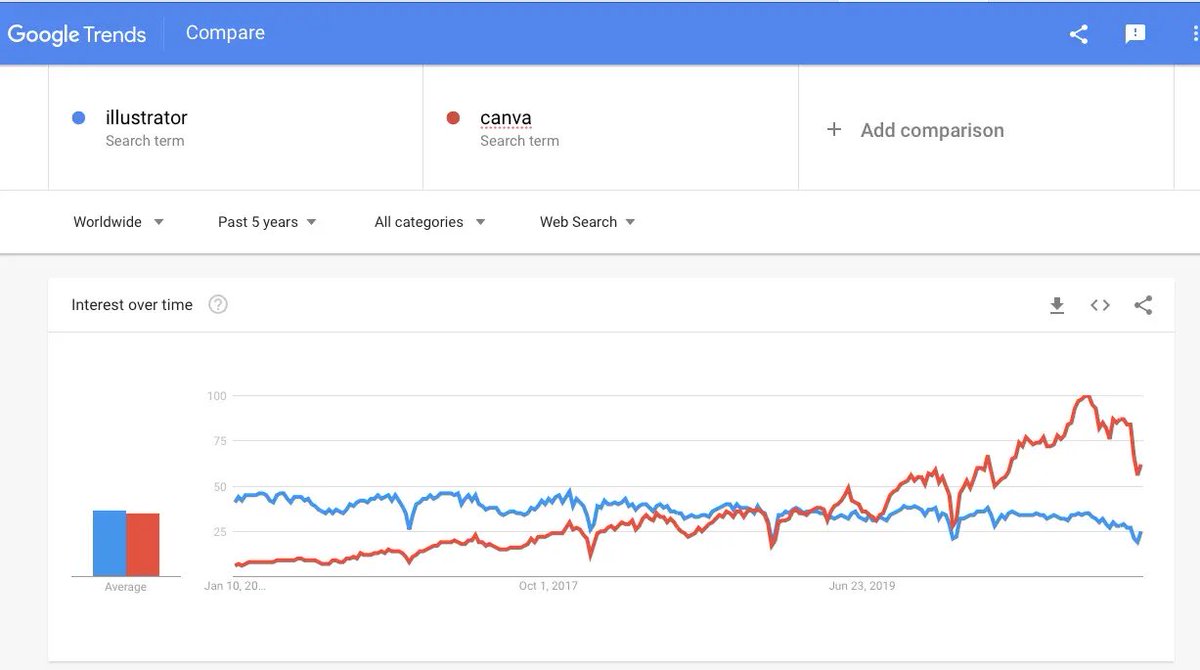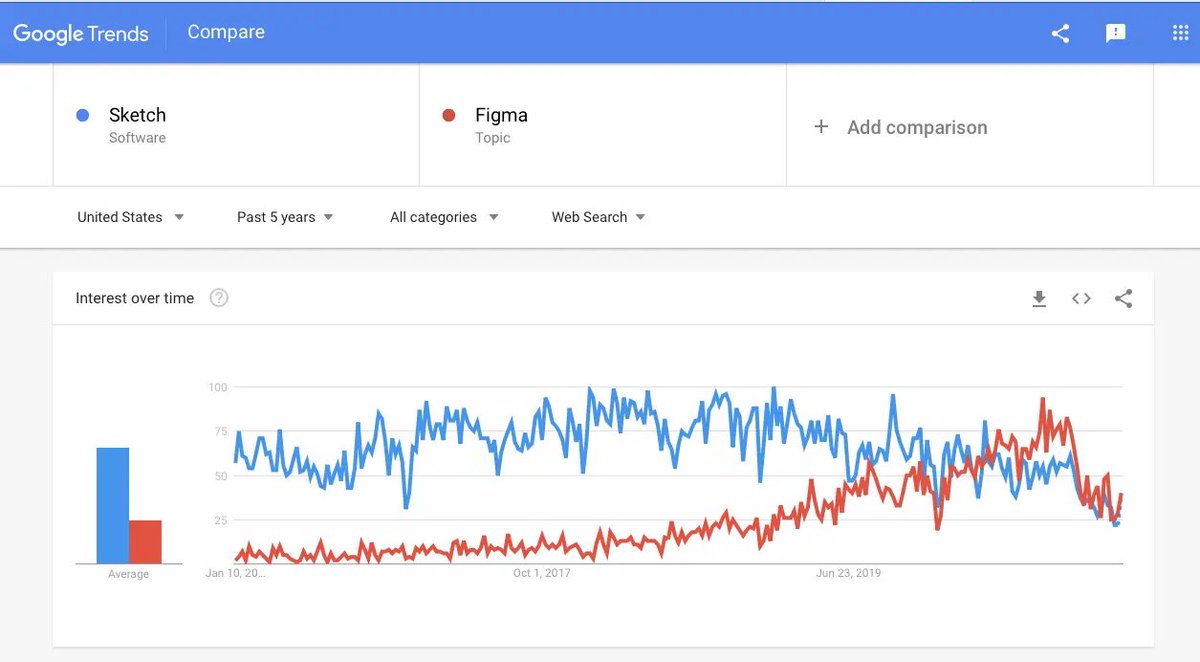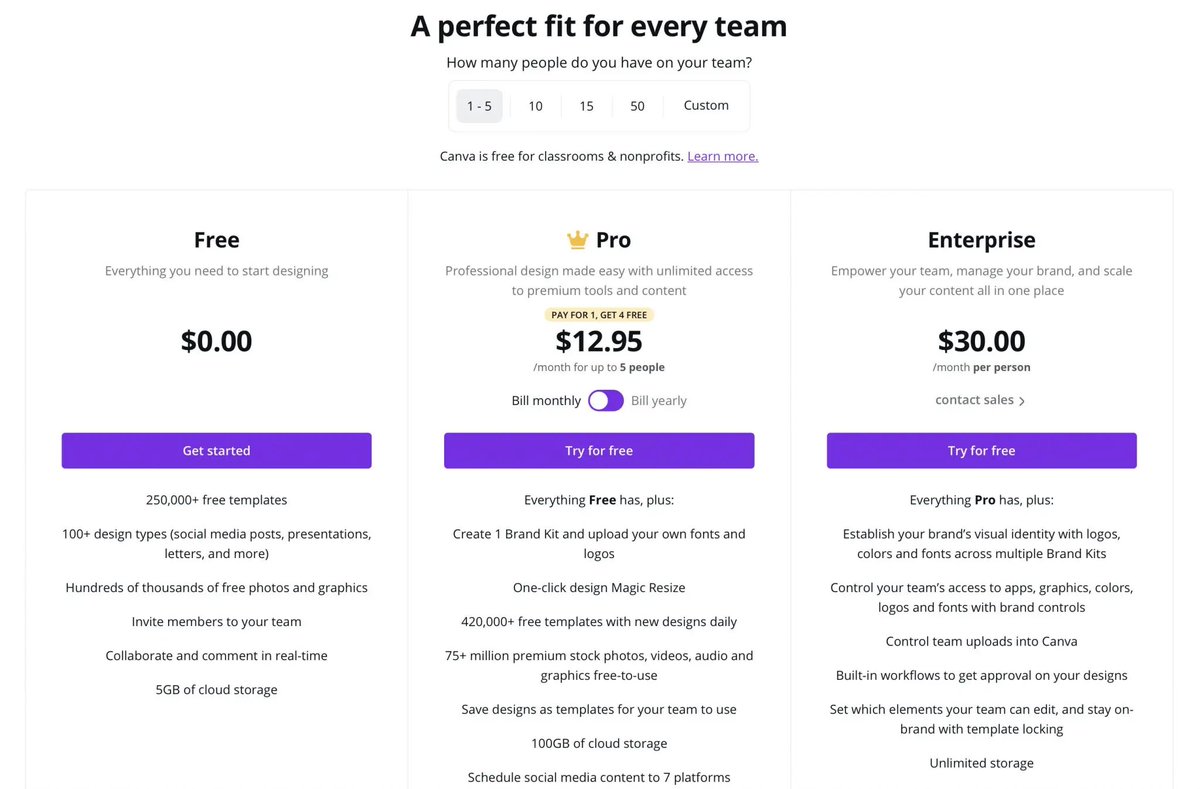I firmly believe freemium pricing is how small startups and indie founders can compete with Unicorns and established competitors.
Just look at @Patticus with @ProfitWell or @MelanieCanva with @canva.
So I’m moving all my side projects to freemium.
Time for a

Just look at @Patticus with @ProfitWell or @MelanieCanva with @canva.
So I’m moving all my side projects to freemium.
Time for a


Notion, Figma, Canva, Profitwell, Mailchimp, and Segment.
What do all of these platforms have in common, besides being category leaders?
Each one has:
- Unseated the previous category leaders with fewer resources
- Opted for a product led growth strategy
- Freemium pricing
What do all of these platforms have in common, besides being category leaders?
Each one has:
- Unseated the previous category leaders with fewer resources
- Opted for a product led growth strategy
- Freemium pricing
But let's back up. How did we get here?
The year is 2012 and the preeminent name in design isn't Sketch or Figma - it's Adobe.
2012 era Adobe is a much different beast to where we are now. 17 thousand videos about their product.
The year is 2012 and the preeminent name in design isn't Sketch or Figma - it's Adobe.
2012 era Adobe is a much different beast to where we are now. 17 thousand videos about their product.
There was no real SaaS model and licenses were hundreds of dollars each, locked to a machine, and didn't get upgrades.
Still, Adobe is unequivocally the category leader.
But in just a few years, that would all change due to an enterprising young entrepreneur.
Still, Adobe is unequivocally the category leader.
But in just a few years, that would all change due to an enterprising young entrepreneur.
Canva launched in 2012 and spread like wildfire.
In 3 years, the company was able to accumulate accumulated 10 million users, with almost 1 million coming in the first year alone. By the next year, they had 17 thousand fan-made videos about their product.
In 3 years, the company was able to accumulate accumulated 10 million users, with almost 1 million coming in the first year alone. By the next year, they had 17 thousand fan-made videos about their product.
This kind of fervent user adoption is the stuff of legend.
I started hearing about Canva around that time. My then-girlfriend (now wife) had put together a project and it looked much better than anything I could knock out in Photoshop or Illustrator.
I started hearing about Canva around that time. My then-girlfriend (now wife) had put together a project and it looked much better than anything I could knock out in Photoshop or Illustrator.
She mentioned it was not only really easy to use, but it was free!
At the time I think I was still bouncing from Adobe license to Adobe license, each of which was half a month's rent, so I was blown away.
At the time I think I was still bouncing from Adobe license to Adobe license, each of which was half a month's rent, so I was blown away.
That space used to be occupied by Adobe, but in a matter of a few years, they were being overtaken in the B2C and even a bit in the B2B space by a brand new company with a limited amount of funding.
Meanwhile, another company, Sketch, was eating away at their market share by offering design-focused tools for modern internet companies.
Adobe had Photoshop and Illustrator, neither of which was purpose-built for the internet and both of which were expensive af.
Adobe had Photoshop and Illustrator, neither of which was purpose-built for the internet and both of which were expensive af.
Adobe XD wasn't quite production-ready at that point, so Sketch was able to make inroads by offering a lower-priced license for its software.
Out of left-field comes the @canva of professional design tools: @figmadesign.
Out of left-field comes the @canva of professional design tools: @figmadesign.
Figma, like Canva before it, quickly discovered the power that a free product with shareable outputs offers.
Users create content with the tool, share the content and then inevitably get asked how it was made.
Users create content with the tool, share the content and then inevitably get asked how it was made.
Of course, the user is both happy to share and give a positive recommendation since the output content is being appreciated, and the platform gains another user.
A couple points to understand about the shiny world of marketing:
1. Recommendations from trusted people always lead to higher conversion rates. It's easy to recommend free things since the only exchange is time.
1. Recommendations from trusted people always lead to higher conversion rates. It's easy to recommend free things since the only exchange is time.
2. Backlinks are everything, still. Google hasn't cracked how to build page authority without backlinks and having them everywhere, attached with positive recommendations and high user dwell time once a user clicks a link, is seen as a positive signal.
3. Creating content in the app means content can be shared outside the app. That's a simple growth mechanism that can be leveraged mightily once a certain user volume has been hit.
4. Finally, email is the best marketing channel still. Freemium platforms exchange email addresses for access and make lead generation a snap.
So Adobe now is taking fire from all sides and they eventually pivot to a cloud-based subscription model while also focusing all their efforts upmarket on the professional landscape, effectively ceding their B2C audience to Canva.
So, how do you implement a freemium pricing strategy that actually works?
Because, the common misconception with freemium is that it’s an easy way to not generate any revenue.
Because, the common misconception with freemium is that it’s an easy way to not generate any revenue.
How many stories have you heard about independent projects that have been worked on for years, only to launch with only a few dollars in revenue, followed by months of slogging before eventually shutting down.
That’s very likely not a pricing problem, but a positioning problem.
That’s very likely not a pricing problem, but a positioning problem.
You need to position your product in front of the right audiences and the price becomes a natural fit for your expansion strategy.
Let's break out the different factors involved in setting up a freemium plan.
Let's break out the different factors involved in setting up a freemium plan.
1. Pricing that scales with usage
If a user wants to dip a toe in and play around with your platform, they can do that at zero cost.
That’s the basic premise of a freemium plan, but what happens when a user is converted and wants to expand their usage?
If a user wants to dip a toe in and play around with your platform, they can do that at zero cost.
That’s the basic premise of a freemium plan, but what happens when a user is converted and wants to expand their usage?
1. (cont) Your pricing should accommodate that natural urge and your product should gracefully allow them to expand their usage with as few barriers as possible.
2. In-app upsells aka feature gating
You need to rope off some of your app so there’s a reason to actually pay.
However, you should charge based on either secondary user value or expanding the primary user value, but ideally both.
Let me explain...
You need to rope off some of your app so there’s a reason to actually pay.
However, you should charge based on either secondary user value or expanding the primary user value, but ideally both.
Let me explain...
2. (cont) Google Analytics made analytics free and accessible to everyone. They charge based on primary user value, but only if you want to expand to a much higher tier of usage. For 99% of people, it will always be free.
2. (cont)
That’s great, but really they only offer expanding their primary user value (analytics) as an upsell. @ProfitWell , one of my favorite companies utilizing this technique, charges entirely on secondary user value.
That’s great, but really they only offer expanding their primary user value (analytics) as an upsell. @ProfitWell , one of my favorite companies utilizing this technique, charges entirely on secondary user value.
2. (cont) They offer Profitwell Retain, a dunning service, on top of their analytics. Analytics are totally free. After all, you already have all your financial information integrated into it and onboarded your team.
2. (cont)
Canva however offers all that and more. They let users expand their primary usage through additional templates, but also access other tools like scheduling posts on social media once you upgrade.
Why pay 12K a year for Hootsuite when you can just upgrade Canva?
Canva however offers all that and more. They let users expand their primary usage through additional templates, but also access other tools like scheduling posts on social media once you upgrade.
Why pay 12K a year for Hootsuite when you can just upgrade Canva?
3. Shareable content
This could be considered a growth loop, since we’re building in some type of publishing into the platform so users can share links.
Our goal with shareable content is to increase the k factor of a user, effectively turning a free user into an influencer.
This could be considered a growth loop, since we’re building in some type of publishing into the platform so users can share links.
Our goal with shareable content is to increase the k factor of a user, effectively turning a free user into an influencer.
3. (cont) Every time they create content in the app and share it externally, you have another potential opportunity for user acquisition which helps balance out the slightly lower conversion rate you’ll see with a freemium plan.
3. (cont)
You can do this with reports, tables, images, videos, etc. If it can be shared inside a team, you should enable it to be published from your platform.
You can do this with reports, tables, images, videos, etc. If it can be shared inside a team, you should enable it to be published from your platform.
4. Massive market opportunity
Freemium works best when you can boil the ocean. No really, let it rip. The ocean should be a massive existing user base or the early signs of a large user base. You will need the volume to make it work with freemium pricing.
Freemium works best when you can boil the ocean. No really, let it rip. The ocean should be a massive existing user base or the early signs of a large user base. You will need the volume to make it work with freemium pricing.
4. (cont)
Here are the TAMs for a few of the examples.
•Canva: Anyone that needs to create images.
•Profitwell: Anyone interested in businesses metrics
•Google Optimize: Anyone that wants to test anything on their site.
•Microsoft Teams: Anyone that uses Slack.
Here are the TAMs for a few of the examples.
•Canva: Anyone that needs to create images.
•Profitwell: Anyone interested in businesses metrics
•Google Optimize: Anyone that wants to test anything on their site.
•Microsoft Teams: Anyone that uses Slack.

5. Pricing innovation on primary value
What does this mean?
A competitive advantage that can’t be innovated against. This is the most important point.
How does Slack compete with Teams when users have Teams included in their subscription?
What does this mean?
A competitive advantage that can’t be innovated against. This is the most important point.
How does Slack compete with Teams when users have Teams included in their subscription?
5. (cont) How does Baremetrics compete with Profitwell when most of what Baremetrics offered is free with Profitwell?
Well...they don’t.
Baremetrics sold.
Slack sold.
You can’t compete against freemium when you’re able to offer the primary value for free.
Well...they don’t.
Baremetrics sold.
Slack sold.
You can’t compete against freemium when you’re able to offer the primary value for free.
5. (cont) The existing market leaders can’t match your pricing without giving up millions in recurring revenue and they’re not going to do that.
That’s how you beat Adobe or fill-in-the-blank industry behemoth.
That’s how you beat Adobe or fill-in-the-blank industry behemoth.
5. (cont) Create a great competitor (the hardest part), offer the primary value for free, then monetize on expanding that primary value or offer a secondary value.
So I'm putting my money where my mouth is. I'm switching over all my side projects to freemium pricing.
As of today:
• http://Snazzy.ai , content marketing powered by GPT-3, now has a free tier
• http://Weld.ai , a Supermetrics alternative, will now be free
As of today:
• http://Snazzy.ai , content marketing powered by GPT-3, now has a free tier
• http://Weld.ai , a Supermetrics alternative, will now be free

 Read on Twitter
Read on Twitter





